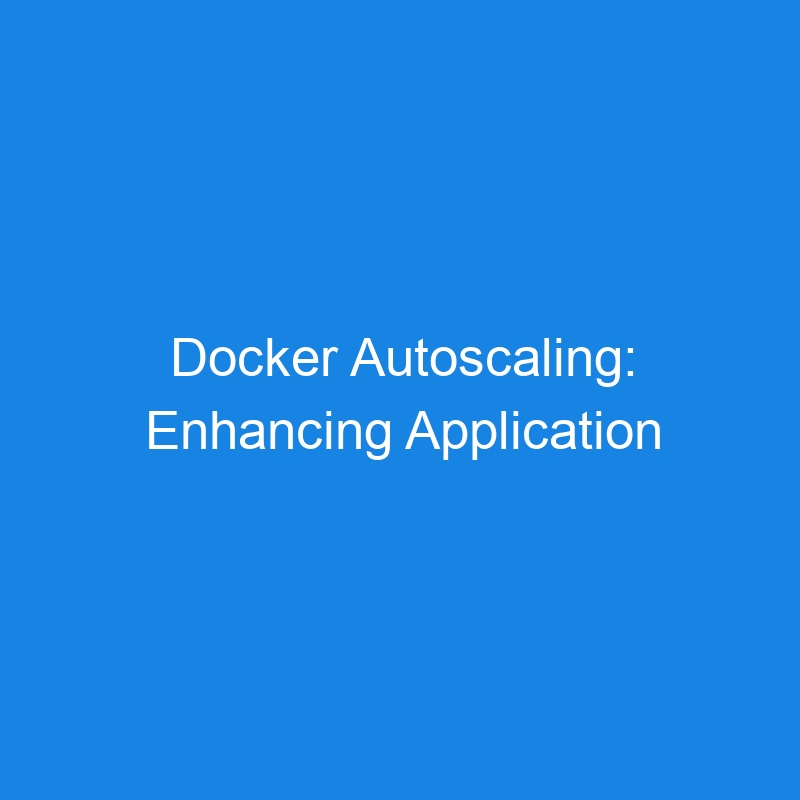Docker Autoscaling: Automatically Adjusting Resources Based on Demand
Docker Autoscaling enables dynamic scaling of containers to handle varying workloads efficiently. This ensures applications maintain high availability and performance while optimizing resource usage. Autoscaling is a critical feature in modern cloud-native and microservices architectures, allowing systems to adapt seamlessly to traffic fluctuations without manual intervention.
Key Features of Docker Autoscaling
-
Dynamic Scaling:
Automatically adjust the number of running containers based on predefined metrics such as CPU usage, memory utilization, or custom application metrics. -
Horizontal Scaling:
Scale out by increasing the number of container instances or scale in by reducing them, depending on demand. -
Vertical Scaling:
Dynamically adjust the resources allocated (CPU, memory) to a container to better handle resource constraints. -
Integration with Orchestration Tools:
Tools like Docker Swarm, Kubernetes, and AWS ECS natively support autoscaling, integrating metrics monitoring and policy management.
Setting Up Autoscaling in Docker Swarm
Docker Swarm provides basic orchestration capabilities for scaling services. While it doesn’t have native autoscaling, external monitoring tools and custom scripts can be used to implement scaling policies.
Steps to Set Up Autoscaling with Docker Swarm:
-
Deploy a Scalable Service:
Deploy services with a specific number of replicas:
docker service create --name my-app --replicas 3 my-app-image
-
Monitor Metrics:
Use tools like Prometheus, cAdvisor, or Docker Stats API to monitor resource usage and trigger scaling based on thresholds. -
Scale the Service Dynamically:
Execute scaling commands based on monitoring alerts:
docker service scale my-app=5
-
Automate Scaling with Scripts:
Combine monitoring alerts with scripts to automate scaling actions:
if [ CPU_Usage > 80 ]; then
docker service scale my-app=10
fi
Setting Up Autoscaling in Kubernetes
Kubernetes offers robust native autoscaling features like the Horizontal Pod Autoscaler (HPA) and Vertical Pod Autoscaler (VPA).
Horizontal Pod Autoscaler (HPA):
HPA adjusts the number of pods based on CPU, memory, or custom metrics.
-
Enable HPA:
Define resource requests and limits for your deployment:
apiVersion: apps/v1
kind: Deployment
metadata:
name: my-app
spec:
replicas: 2
template:
spec:
containers:
- name: my-app-container
image: my-app-image
resources:
requests:
cpu: "500m"
memory: "512Mi"
limits:
cpu: "1"
memory: "1Gi"
-
Apply HPA:
Use the following command to scale pods dynamically:
kubectl autoscale deployment my-app --cpu-percent=50 --min=1 --max=10
-
Monitor HPA:
Check autoscaler status with:
kubectl get hpa
Vertical Pod Autoscaler (VPA):
VPA dynamically adjusts resource requests and limits for containers to optimize performance.
Best Practices for Docker Autoscaling
-
Define Clear Metrics:
Base scaling decisions on metrics like CPU, memory usage, request latency, or custom application metrics. -
Set Resource Limits:
Always define resource requests and limits to avoid overcommitting or underutilizing resources. -
Test Scaling Policies:
Test scaling configurations in staging environments to ensure seamless scaling in production. -
Use Monitoring Tools:
Integrate monitoring tools like Prometheus, Grafana, or AWS CloudWatch for real-time insights and alerts. -
Optimize for Cost:
Use autoscaling to minimize costs by only running the necessary number of containers during low-demand periods.
Benefits of Docker Autoscaling
-
High Availability:
Ensures that applications remain responsive during traffic surges. -
Optimized Resource Utilization:
Prevents over-provisioning and minimizes wastage by scaling based on actual needs. -
Reduced Operational Overhead:
Automates scaling, reducing the need for manual intervention. -
Improved Performance:
Maintains application performance by automatically allocating resources during high demand.
Conclusion
Docker Autoscaling is an essential feature for modern, cloud-native applications. Whether implemented via Docker Swarm or Kubernetes, it ensures optimal resource usage and application performance under varying workloads. By leveraging autoscaling effectively, teams can achieve high availability, reduced costs, and streamlined operations.
